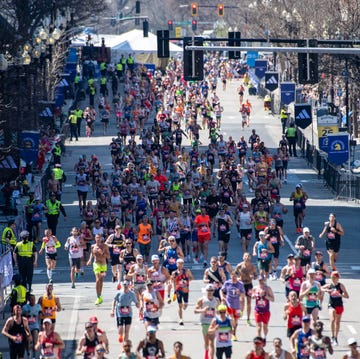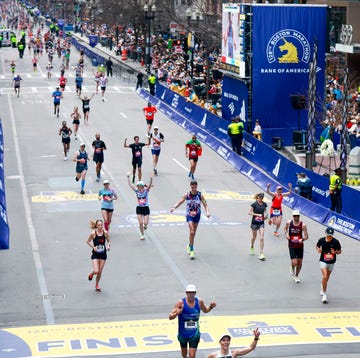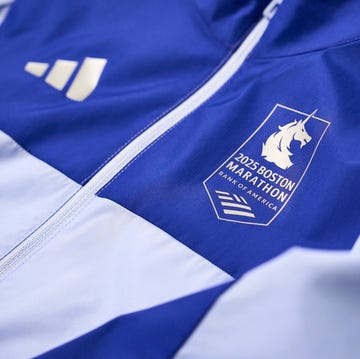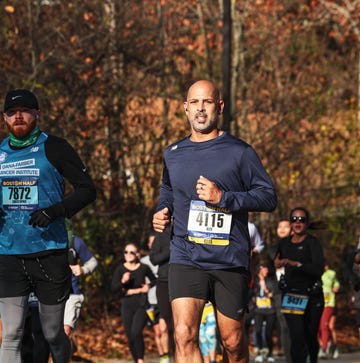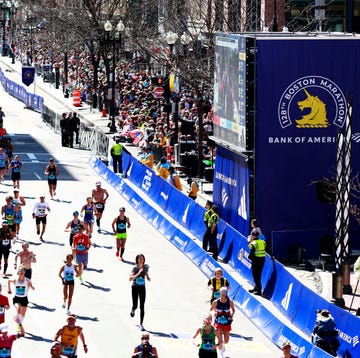The 1983 Boston Marathon champion Greg Meyer is a member of the Boston Athletic Association (B.A.A.). So is Bobbi Gibb, women’s champion during the “pioneer era” of the marathon in 1966, ’67, and ’68.
But Kathrine Switzer, who made headlines in Boston in 1967, is not. Nor is Meb Keflezighi, the 2014 champion.
Tom Grilk, the CEO who retired in April, has been a member since 1987. The new CEO, Jack Fleming, is not.
Michael O’Leary, M.D., a surgeon at Brigham and Women’s Hospital and chairman of the B.A.A.’s Board of Governors (which is essentially the same as a board of directors) has been a member of the B.A.A. since 1989. All 13 Governors (10 men, three women) are members—they have to be, in order to be picked to serve on the board.
Scott Peterson, a Miami-area corporate finance professional, is a member, and he has his membership listed prominently on his LinkedIn profile. When asked by Runner’s World about it, Peterson, a marathon veteran, called the group “like-minded people who support the running community.” He said, “It’s a real honor for me and anyone to be part of the membership of B.A.A.”
But what is this selective group, exactly? Who are they? And how are they chosen?
A local mystery
Information about membership on the B.A.A. website is scant, which cloaks the group—intentionally or not—in secrecy. Several people who are deeply involved in the Boston-area running community told Runner’s World they did not know such a group existed. (There is also a B.A.A. Running Club, which is open to runners in the Boston area, but it is different from the membership.)
Chris Lotsbom, a B.A.A. spokesperson, answered multiple questions from Runner’s World about the membership via email. He said the group currently has 174 people.
He also explained that the membership model goes back to the B.A.A.’s founding in 1887. The marathon started 10 years later, in 1897.
The organization had, in its earliest days, a building with a pool, indoor track, bowling alley, and boxing room, among other amenities, like a golf club, for its dues-paying members. The B.A.A. was similar to other athletic clubs across the country, most notably the New York Athletic Club, which still exists.
In the 1930s, during the Great Depression, the B.A.A. lost its headquarters building and its other properties. All that remained was the marathon, the bylaws of the organization, and a small group of members.
The members kept the B.A.A. and the marathon going. And they remain to this day, written into the organization’s bylaws to promote “the common good and the health and welfare of the general public and the encouragement of the general public to improve their physical condition.”
Tom Derderian, executive producer of Boston: The Documentary and author of Boston Marathon: Year-by-Year Stories of the World’s Premier Running Event, takes a skeptical view of the leadership back in the day.
“The B.A.A. expected that their investments in the 1920s would continue to grow,” he wrote to Runner’s World. “The stock market crash and Depression and World War II removed all B.A.A. assets, leaving the Association with only its name, an indoor track meet, the Boston Marathon—and the founding attitude that only B.A.A. members could know what was best.”
The modern-day membership
Today, as with any group, some members are actively engaged in day-to-day matters of the organization, attending meetings, voting, lending expertise, or volunteering at B.A.A. events. Others are not involved at all.
“For us today, membership is a valuable asset when tapped into,” Fleming said in a call with Runner’s World. “There’s still work to be done, but leadership and staff rely on the members for a variety of things. They serve on committees. They provide guidance in areas, their expertise. So finance, real estate, of course, running, community, the professional side, technology.”
For example, when the B.A.A. wanted to buy a building in Hopkinton near the marathon starting line, the organization got real estate advice from some of the members during the process.
They have also helped with recent diversity initiatives.
“Several B.A.A. members were significant in the establishment of the Boston Running Collaborative, which seeks to increase the fitness and participation of minorities in running,” Lotsbom wrote. “In this respect, membership is a resource which complements the staff’s day-to-day work.”
The way the bylaws are written, the Board of Governors are nominated from the membership. So the 174 members influence the direction of the B.A.A. through the Governors, who oversee the CEO.
The B.A.A. doesn’t track the demographic makeup of the membership, but Lotsbom wrote that, since 2010, the group has attempted to improve its diversity.
Thaddeus Miles, who founded the Road to Wellness 5K in Roxbury several years ago, was invited to join the membership two years ago by Tom Grilk. Miles recently showed up at his first in-person membership meeting post-pandemic. He counted only one other Black member among what he estimates were 50 attendees, plus Adrienne Benton and Keith McDermott, who are on the Board of Governors.
Three people who are familiar with the membership said that many members work in the medical professions or financial services industry in the Boston area.
There is a family component as well, according to the B.A.A. O’Leary’s father, also a physician, was a member of the B.A.A. who was responsible for the physicals administered to marathon runners in Hopkinton during the race’s earlier years. A descendant of Walter Brown, who founded the Boston Celtics and was the B.A.A. president from 1941–64, still starts a division of the marathon to this day.
Members pay a nominal fee—$50—each year to belong. In exchange, they get one waiver each year into the marathon. They still have to pay the entry fee ($375), but they can run themselves without qualifying, transfer the waiver to a friend or family member, or donate the number to a charity.
Miles, who is on the steering committee of the Boston Running Collaborative, gives his waiver for a marathon entry every year to a runner of color who otherwise wouldn’t be able to qualify for the race.
For the thousands of runners every year who try to qualify but fail, or who fundraise for one of the charity teams as a way of gaining entry to Boston, the existence of a small membership group might rankle. Lotsbom said fewer than 180 entries are allocated for members annually (out of a field size of 30,000) and less than half are ultimately used.
“The B.A.A. gets to choose whom they want to invite to run the race, and the B.A.A. decides the terms by which it will invite people to participate in its iconic annual event,” said Robert Wang, the founder of the World Marathon Majors Challenge group on Facebook. (The group’s 18,000 runners are seeking to run all six of the Abbott World Marathon Majors, but they have no official affiliation with that organization.)
“If the B.A.A. wanted to invite everyone whose last name starts with ‘Y’ to run the Boston Marathon, that would absolutely be the organization’s prerogative,” Wang said.
I’d love to be a member. How do I sign up?
There’s the rub. Right now, no such sign-up mechanism exists. You have to know a current member or someone on the Board of Governors.
“Potential members are traditionally nominated by a board member or another current member, and apply with a résumé along with specific comments as to why they wish to join the B.A.A.,” Lotsbom wrote. “From there, the nominees are seconded by a Governor, and voted on by the board. The membership is made up of those who have expressed an interest in the B.A.A., B.A.A. activities, and its mission.”
Fleming acknowledged that the relative obscurity of the membership and the lack of clear guidelines for becoming a member could be improved.
“We should make it known more,” he said. “And we should have more public ways of making it easier to have their interest become known. Raise your hand. We should make it easier for that to occur.”
In an era when running’s leaders are trying to make the sport more inclusive, how does the B.A.A.’s membership fit into the landscape? Is it a quirky echo of the organization’s past? Or an impediment to diversity in today’s world? Does a quiet group of invitation-only members pass the sniff test in 2022?
Tiffany Chenault, a sociology professor at Salem State University who is an ambassador for the Boston chapter of Black Girls Run and part of the Boston Running Collaborative, said in a call that she didn’t recall hearing about the membership, and she wondered how much influence the group holds.
“I’m curious,” she said. “I have questions.”
John Hanc, a longtime Runner’s World contributing editor and author of The B.A.A. at 125: The Official History of the Boston Athletic Association 1887-2012, knew of the group’s role in the B.A.A.’s founding, but he didn’t realize it still existed.
“Today we know the B.A.A. for the marathon and its other major running events,” Hanc said.
“But we have to remember that its history is rooted in the 19th century. Back then, it was very much an athletic club, with all of the exclusivity and, by 21st century standards, perhaps unnecessary and stuffy protocol that came with institutions like it at the time. Over the decades, the organization has morphed into a powerful force in the modern running movement. But some vestiges of that past still remain. While we of course want to see greater diversity in every aspect of the sport, this remnant of the old B.A.A. strikes me as fairly harmless.”
The B.A.A. in 2022 is facing very modern challenges, however. John Hancock, the longtime marathon sponsor, announced that 2023 would be its final year. Will a company want to replace Hancock? And critics have said the B.A.A. has been slow to embrace diversity in its ranks and events. Where does the membership group fit into that?
Does a leadership structure that evolved from the 19th century, and with a Board derived from a membership group, still serve the organization?
Derderian isn’t certain.
“It is a human tendency for those in charge to conclude that only they know enough to be in charge, since they have always been in charge,” he wrote, “and to keep things from changing, they have to continue to exclude control from outside.”

Sarah Lorge Butler is a writer and editor living in Eugene, Oregon, and her stories about the sport, its trends, and fascinating individuals have appeared in Runner’s World since 2005. She is the author of two popular fitness books, Run Your Butt Off! and Walk Your Butt Off!



